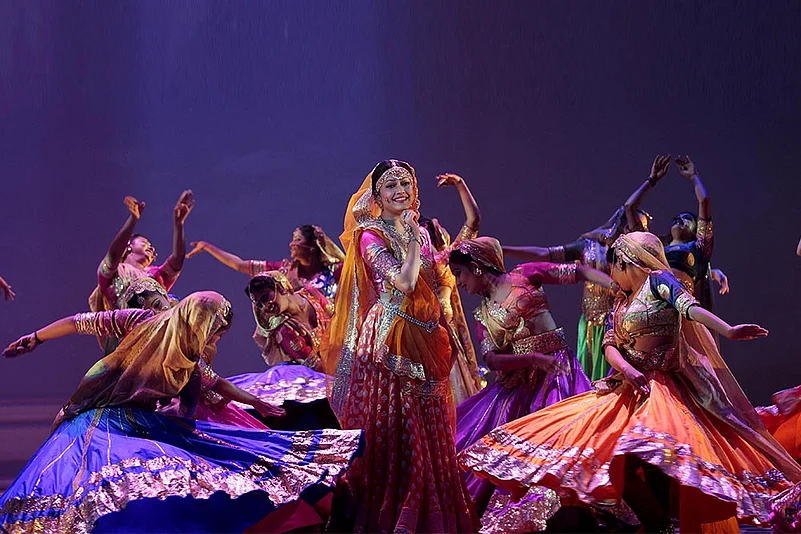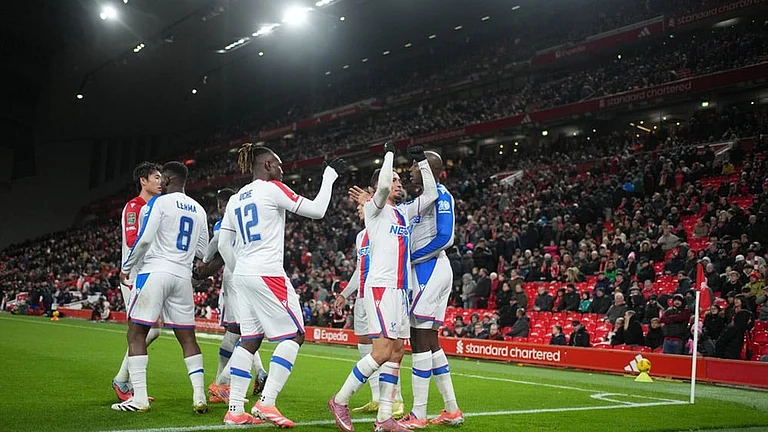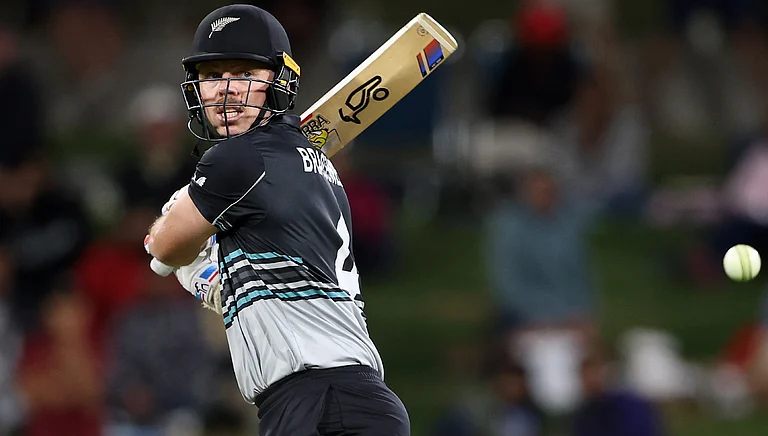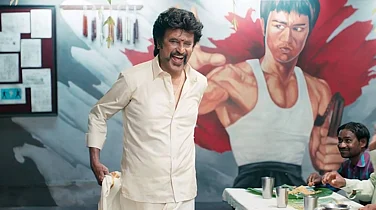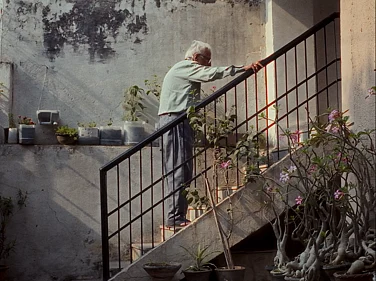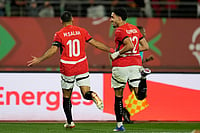The luminous background screen with a full moon and a few stars on pink-purple-mauve hues, and a projection of the Mughal arches on the front curtains do not adequately prepare you for the next moment when the dancers, dressed to the hilt, trot in for the performance of Mohe panghat pe. As Priyanka Barve takes to the stage, dressed in a Manish Malhotra ghagra, choli and ghungat, a new Anarkali is born. She swirls and sings one of the most popular song-dances essayed by one of the greatest characters on Indian cinema—Salim’s star-crossed lover in Mughal-e-Azam, K. Asif’s 1960 epic drama on celluloid.
This isn’t a mere reproduction of the famous songs or scenes or dialogues from the legendary film. With top-of-the-line producers, designers and technicians, director Feroz Abbas Khan has brought the film to theatre in the form of a two-hour-long grand musical. At the Jamshed Bhabha Hall of the National Centre for Performing Arts (NCPA), final touches are being given to the designs, steps and choreography. If the six-minute dress rehearsal of Mohe panghat pe, a song immortalised by Lata Mangeshkar, the singer, and Madhubala (as Anarkali, in her debut dance performance in Emperor Akbar’s court), Mughal-e-Azam, the musical, is on its way to becoming an apt tribute to Asif’s film.
“The musical is faithful to the film but this is theatre—there is live singing and performing,” says Feroz Khan, who has directed plays such as Tumhari Amrita and the film Gandhi, My Father. “All the memorable scenes have been retained. I wouldn’t remake it as a film, no one can make the same film ever again.” However, he makes it clear that it is in no way a literal copy. Of course, there are no big stars like Prithviraj Kapoor, Dilip Kumar and Madhubala, but top technicians from Broadway have been roped in to ensure that the musical will retain the grandeur of the original. Priyanka Barve, a trained classical singer, plays Anarkali, while Sunil Kumar Palwal and Nissar Khan perform Salim and Akbar, respectively. Feroz Khan says Priyanka was selected after many rounds of auditions. “First, we needed a very good singer, who could also dance gracefully and act. The rigour and discipline required for this kind of a musical wasn’t possible for many,” he says.
Mughal-e-Azam, first released in 1960 and then remastered in 2004, was the most expensive and elaborate film of that time. It was made over a period of nine years, with some portions shot in colour towards the end. The stories about the construction of the ‘shish mahal’ for the song Jab pyar kiya toh darna kya became the stuff of legend, not to mention the performances that were extraordinarily dramatic and intimate at the same time. Richard Nowell, who handles the sound department, says he had to pay special attention to ensure that the contrast was maintained and, in fact, enhanced. “We wanted the extremes—the battle scenes and the dances and then the whispered conversations.” Now, Neil Patel and David Lander, who handle production and light design, are also keen to create the maximum effect through a “minimalistic approach” in recreating the grandeur of a “precious, Indian epic love story”. Khan and his team have used high-quality light projections to depict the story, which unfolds in lush Mughal gardens and has aggressive battle scenes and melodramatic exchanges. Study of Mughal architecture was inherent to the design conceived by the award-winning technicians of Broadway.
The overriding sentiment is of depicting the “story of love” among the huge team assembled all over the world, starting with the co-presenters Shapoorji Pallonji. Deepesh Salgia, who represents the construction group that financed the film 56 years ago, says they were keen to retain the ethos and the art. “In those days, Asif saw the potential to transform the play Anarkali (the original play staged in 1930s/40s) into cinematic grandeur because of the new technology that was becoming available to the Indian film industry,” says Salgia. “Now, with technological advancements in theatre, we believe we will be able to blend the drama and do justice to the scale of the film. We believed that the best in all departments had to be roped in to create Mughal-e-Azam, the musical, and not Anarkali, the play.”
After the sets and lights, the other crucial element was costumes. Manish Malhotra, one of Bollywood’s favourite costume designers, who is looking at a very busy wedding season ahead, entered the world of theatre for the first time. Attempting to amalgamate history and the film, Malhotra insists that efforts were to make the actors, who are quite different from Bollywood stars, come out stronger. A fan of films like Pakeeza, Awaara and Mughal-e-Azam, Malhotra says, “We needed a lot of preparation, but we are clear that it is a theatrical adaptation. In theatre, the lighting, the colour, are all different, there are quick changes of costumes and no scope for a retake. The costumes cannot be overwhelming.”

Madhubala and Dilip Kumar as Anarkali and Salim in K. Asif’s movie
Mayuri Upadhya, the choreographer, who runs Nritarutya Dance Trust in Bangalore, probably had her task cut out. She has choreographed songs from the film and two original numbers, including a Sufi song. As dancers practise their exact posture and a split-second graceful dash to pick up the plate full of lights, Khan is acutely aware of the comparisons. “People will come to the show with memories,” he says, but he is neither trying to create a historic play true to facts nor is he emulating the great performers from the film. “This is fun-history. It has to be clear that it is not a museum walk for the audience. The first thing I abandoned was research. The musical is a tribute to the movie.”
The excitement and anxiety among the bustling team reminds you of the scene where Anarkali is to perform in a muqabla, to be judged by Salim. After a riveting sawaal-jawaab in the song-dance Teri mehfil mein kismat azmaakar hum bhi dekhenge, Salim gives a rose to Anarkli’s opponent and thorns to her. That’s when Madhubala whispers her immortal lines, “Kaanton ko murjhane ka khauf nahin hota… (thorns aren’t afraid of withering away)” and at once rises above everyone else in the scene. Whether Feroz Khan’s Anarkali achieves this or not is another matter, but for now, a trip to this musical to experience some of the best lines ever written and mesmerising performances ever choreographed will quell all curiosity.






